 Rainy season. Two words that are almost sure to make you rethink your holiday plans.
Rainy season. Two words that are almost sure to make you rethink your holiday plans.
Like Costa Rica in soggy September, when anyone visiting this small central American country is bound to need a raincoat.
So why go to a place knowing you’re likely to get drenched, when you can pick other months that promise glorious sunshine?
The crowds, that’s why. I’d far rather run the risk of rain rather than face a flood of other travellers.
Over-tourism is spoiling destinations around the world, and it’s only a matter of time before Costa Rica goes the same way. Already in the high season, tickets for the most popular national parks sell out weeks in advance, long queues form at the entrances, and if someone spots a monkey or, even better, a sloth, you’ll join another queue for a mere brief moment of viewing time.
 Just how wet is Costa Rica’s notorious rainy season? Well, it may be urban legend, but my tour guide Alan Cespedes of Travel Excellence claims the reason its banknotes are now made of plastic is because paper notes used to disintegrate in the rain.
Just how wet is Costa Rica’s notorious rainy season? Well, it may be urban legend, but my tour guide Alan Cespedes of Travel Excellence claims the reason its banknotes are now made of plastic is because paper notes used to disintegrate in the rain.
While it was often quite entertaining to feel warm pelting drops after a morning of bright sunshine, it does get more serious. Alan was late to reach our starting point in San Jose because his flight from the south of the country was cancelled due to thunderstorms. My own flight in from Lima almost diverted to Panama before the storm eased enough to land. And our bus driver had to find an alternative road to Poas Volcano after downpours triggered a landslide that blocked the usual route. For me, it all added to the adventure of exploring one of the world’s most celebrated countries for wildlife and environmental protection.
Because it’s so small you can easily experience several different ecosystems in one vacation. The difficult part is choosing which. There are cloud forests and rainforests, volcanoes and valleys, 28 reserves and national parks, and beaches on both the Caribbean and Pacific coasts.
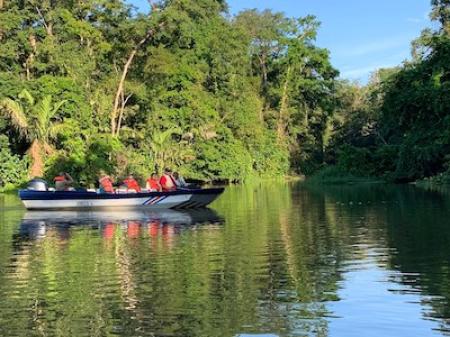 Although the country covers only 0.03% of the world’s land mass, it’s home to an estimated 5% of all species. That’s about 500,000 types of flora and fauna. Yet it wasn’t always the Garden of Eden that it’s portrayed as today. Deforestation was rampant in the past to clear space for mono-culture farming and cattle ranches that damaged the environment. The vision of reversing the destruction has certainly been in play for decades, however, with one travelling companion sporting a t-shirt she bought there 29 years ago declaring: “Only when the last tree has died, the last river has been poisoned, and the last fish has been caught, will we realised that we cannot eat money.”
Although the country covers only 0.03% of the world’s land mass, it’s home to an estimated 5% of all species. That’s about 500,000 types of flora and fauna. Yet it wasn’t always the Garden of Eden that it’s portrayed as today. Deforestation was rampant in the past to clear space for mono-culture farming and cattle ranches that damaged the environment. The vision of reversing the destruction has certainly been in play for decades, however, with one travelling companion sporting a t-shirt she bought there 29 years ago declaring: “Only when the last tree has died, the last river has been poisoned, and the last fish has been caught, will we realised that we cannot eat money.”
Not quite everything is fine yet, however. Alan spoke candidly about some of the ongoing failings. As we passed vast banana plantations he told us how pesticides that are banned elsewhere in the world are still used here, causing birth defects and illnesses in humans and wildlife. As we drove on we saw a crop-spraying plane taking off from a little airstrip, about to spread more chemicals. The problem is so bad that in 2022 the United Nations Development Program warned Costa Rica that its overuse of pesticides was threatening the lives of workers.
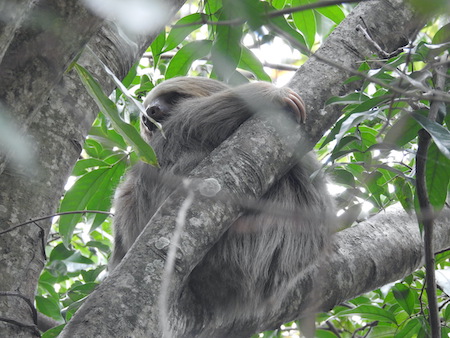 Yet its achievements in other areas are outstanding. It generates more than 98% of its electricity from renewable sources, and vast tracts of land have been rewilded. Even in the capital, San Jose, there’s a large forest on the University of Costa Rica campus, created over the past 60 years by replanting what was once a cattle ranch.
Yet its achievements in other areas are outstanding. It generates more than 98% of its electricity from renewable sources, and vast tracts of land have been rewilded. Even in the capital, San Jose, there’s a large forest on the University of Costa Rica campus, created over the past 60 years by replanting what was once a cattle ranch.
The most mature sections are magical with soaring trees and clinging vines, and somehow, sloths have managed to move in. Some of the university’s biologists have formed a company called Oropopo (spectacled owl) to offer eco-friendly experiences such as a tour around the campus, where biologist Raquel Bone found me more sloths in two hours than I saw in two weeks on tour.
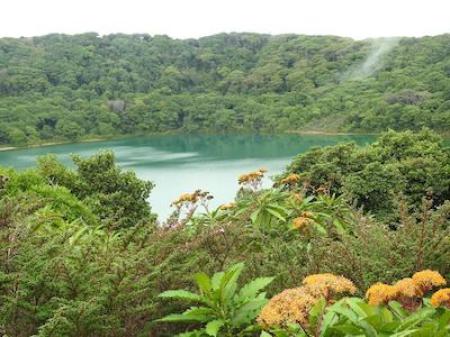 My three-week trip was a great combination, with a highlight being the eco-friendly accommodation. There are some fabulous lodges surrounded by highly audible nature – from cicada choruses to demons-from-hell howler monkeys - but with the luxuries of swimming pools, delicious food and excellent service.
My three-week trip was a great combination, with a highlight being the eco-friendly accommodation. There are some fabulous lodges surrounded by highly audible nature – from cicada choruses to demons-from-hell howler monkeys - but with the luxuries of swimming pools, delicious food and excellent service.
The hike around Poas Volcano and Botos Lagoon is breathtaking, and not only because of the views. Poas is an active volcano an hour north of the capital, with a main crater a mile in diameter that was burping out grey smoke. A ‘volcanometer’ was flashing a reassuring blue to show that the gas was at a tolerable level for sightseeing. If it starts flashing red, it’s time to scarper. Another track leads to the beautiful lagoon formed in an dormant crater, giving me a good work-out of high-altitude exercise.
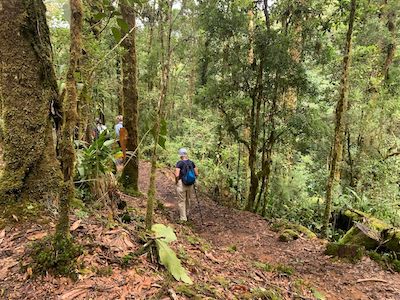 To the south of San Jose is Savegre cloud forest, where my wildlife spotting began. Savegre Nature Reserve and Spa lodge has trails leading into the cloud forest, and my companions and I set off with cameras, binoculars and hiking boots. Two hours later I returned to seek out the jacuzzi and sauna. Wild, but with comfort. That’s my kind of holiday.
To the south of San Jose is Savegre cloud forest, where my wildlife spotting began. Savegre Nature Reserve and Spa lodge has trails leading into the cloud forest, and my companions and I set off with cameras, binoculars and hiking boots. Two hours later I returned to seek out the jacuzzi and sauna. Wild, but with comfort. That’s my kind of holiday.
Wildlife spotting is a profession, not just a passion, and my walks were much more rewarding with a guide like Alan, who knows how and where to spot stuff. I’d never find a sloth by myself, for example. But a guide who knows which trees these quaint furballs prefer can open your eyes to a new world.
Other strange creatures we spotted included Jesus Christ lizards running across the water on their hind legs; spider monkeys swinging through treetops; iguanas basking on the beach; and huge blue morpho butterflies, which cunningly mimic the face of an owl when they close their iridescent wings.
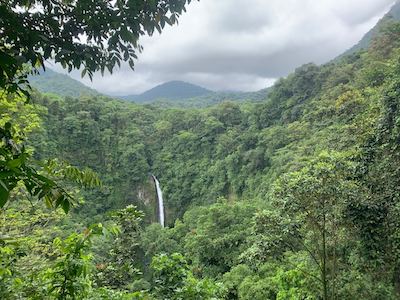
All the rain makes Costa Rica a great place for watersports, and it’s huge fun to go rafting along the Pacuare River. There are calm stretches enclosed on both sides by forest, then turbulent patches for paddling rapidly as our guide Manuel issued instructions, always with a polite ‘please’ and ‘thank you’. The people here are generally lovely, with a ready smile and a greeting of ‘pura vida’, their catchphrase meaning pure life, and also used for hello, goodbye, how are you, and everything’s great, thanks. It’s such a national motto that it even features on the bank notes, in microscopic letters hidden in tiny pictures of turtles.
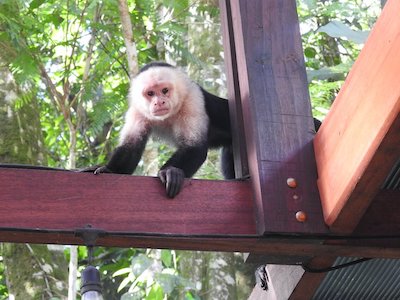 For real turtles the centre of activity is Tortuguero on the Caribbean coast. This was my favourite national park, mainly because you get there by boat through a bewitching network of jungle waterways. Our cabins at the Evergreen Lodge were wonderful, with no glass in the window frames so you can hear the noises of the jungle. (Thankfully there are mosquito nets to keep the creatures themselves out). White-faced capuchin monkeys would jump in immediately if you let them. They hang around the restaurant ready to pounce if a careless guest leaves any food unattended. It’s an ongoing game, with capuchins looking like the evil face-painted Joker and waiters shooing them off with water pistols.
For real turtles the centre of activity is Tortuguero on the Caribbean coast. This was my favourite national park, mainly because you get there by boat through a bewitching network of jungle waterways. Our cabins at the Evergreen Lodge were wonderful, with no glass in the window frames so you can hear the noises of the jungle. (Thankfully there are mosquito nets to keep the creatures themselves out). White-faced capuchin monkeys would jump in immediately if you let them. They hang around the restaurant ready to pounce if a careless guest leaves any food unattended. It’s an ongoing game, with capuchins looking like the evil face-painted Joker and waiters shooing them off with water pistols.
Tortuguero itself is a car-free village, with a long stretch of laid-back bars and restaurants flanking the beach. An informative museum is dedicated to the turtles that nest along the coastline, and from June to September you can go on a night trip to watch them lay their eggs. I didn’t go, feeling it would be too intrusive despite promises that no flashlights are allowed. The next day my friends reported that it was a wonderful sight, but marred by too many humans.
On the Pacific side of the country lies Manuel Antonio National Park, where the forests meet wide beaches. Wildlife spotting demands good eyesight, but even myopic me managed to see playful spider monkeys, a foraging agouti wandering perilously close to a curled up python, and a hairy ball of sloth high in the trees.
Although Costa Rica has officially closed all its public zoos, there are several wildlife centres where injured animals or those rescued from the pet trade are cared for and rewilded if possible. There are also plenty of butterfly gardens, numerous botanical gardens, and colourful plants cascading everywhere. Colour is one of the things that will stay in my memory – flowers of vivid yellow, red, fuchsia and magenta. Butterflies of shimmering blue and lilac. Turquoise seas, and houses painted in jaunty pinks. Yes, I’ll remember Costa Rica’s colours. And that essential, unpredictable rain.